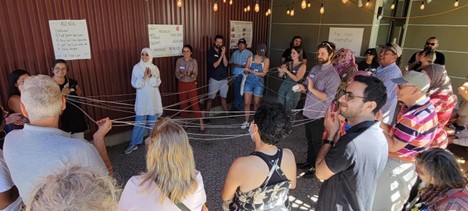Researchers from the University at Buffalo Food Lab were the driving force behind the publication today of a major report that details strategies local governments in low- and middle-income countries can use to create more innovative and equitable community food systems.
The 164-page report — titled “Local government planning for community food systems” — was published in early February 2021 by the Food and Agriculture Organization (FAO), a United Nations agency that leads international efforts to defeat hunger.
“To my knowledge, this is one of the earliest documents outlining how local governments can take action to create innovative and equitable food systems in low- and middle-income countries,” said Samina Raja, PhD, director of the UB Food Lab, who shepherded the initiative.
The report was co-produced by researchers and community partners in the case study countries, along with authors Raja, Erin Sweeney, Yeeli Mui and Emmanuel Frimpong Boamah of UB’s Community for Global Health Equity and the Food Lab. It includes contributions from 10 students and six community partners from Ghana, Jamaica, and India.
Sweeney coordinated the work in Odisha (India), while Mui led in Kerala, India, and Frimpong Boamah in Ghana. Mui was a postdoc at UB when the project started and is now an assistant professor in the Bloomberg School of Public Health at Johns Hopkins University.
UB researchers were the driving force behind this report published by the Food and Agriculture Organization of the United Nations.
A food system is the rich and complex web through which a community gets its food.
Despite major developments, local governments in low- and middle-income countries continue to face significant challenges in integrating food security, nutrition and sustainable food systems in their agenda, FAO directors Anna Lartey and Vimlendra Sharan note in the foreword to the report.
“This publication invites us to rethink food systems and supply chains through the lens of a ‘community,’ as a reminder that people and their everyday practices and relationships with food are central to the design of these processes,” they write.
The report comprises six sections featuring contributions from UB and other global food systems researchers. Topics covered include describing the many ways in which local governments influence a community’s food system, an overview of the field of food systems planning, examples of local government policies from across the globe, and case studies from a number of low- and middle-income countries where food systems present an opportunity for equitable innovation.
“In its conclusion, the report reinforces the critical role of community food systems for broader social transformation in cities and regions,” says Raja, who also serves as co-director of UB’s Community for Global Health Equity.
The report is unique in that it is centered around the experiences of smallholder farmers in low- and middle-income countries. These farmers are responsible for growing food for the world and yet they are often the most food insecure, Raja points out.
“It is with this premise that we went about this work,” she says, adding that the team interviewed smallholder farmers in Ghana, India and Jamaica. “It became certain that it is impossible to prepare plans and policies without understanding the successes, challenges and adaptations made by smallholder farmers to do their job and survive. They feed the world, they fight climate change, they protect our ecologies — smallholder farmers are truly on the ‘frontline.’”
Raja says local governments have the ability and a responsibility to collaborate with stakeholders to harness and amplify the opportunities available within their jurisdiction to develop more innovative and equitable community food systems.
“There is no one-size-fits-all approach to food systems planning,” she says. “Each community’s opportunities and challenges are unique. Building community trust, designing inclusive planning processes, and conducting contextually scoped community food system assessments that center smallholder farmers’ experiences are key to planning, strengthening, and leveraging food systems for community well-being in low- and middle-income countries.”
The report was the result of a collaboration between FAO and UB, which have partnered to build the capacity of local governments to engage in food systems planning. UB began work with partners at FAO in 2016 with an expert summit focused on drawing attention to food in the New Urban Agenda, an initiative of the U.N. that aims for a better quality of life in the urbanizing world.
With support from FAO, researchers at the UB Food Lab are conducting transdisciplinary research in Ghana, India and Jamaica to document opportunities and challenges in planning for food systems, especially from the perspective of smallholder farmers.
“UB’s Community for Global Health Equity, which supports UB Food Lab’s global work, is committed to supporting those who most influence global food equity – leaders, organizations and policymakers who can affect systemic change,” said Venu Govindaraju, PhD, UB vice president for research and economic development.
“The FAO-UB partnership accelerates our faculty’s ability to translate their research in the domain of community food systems into policy and action,” Govindaraju added.






